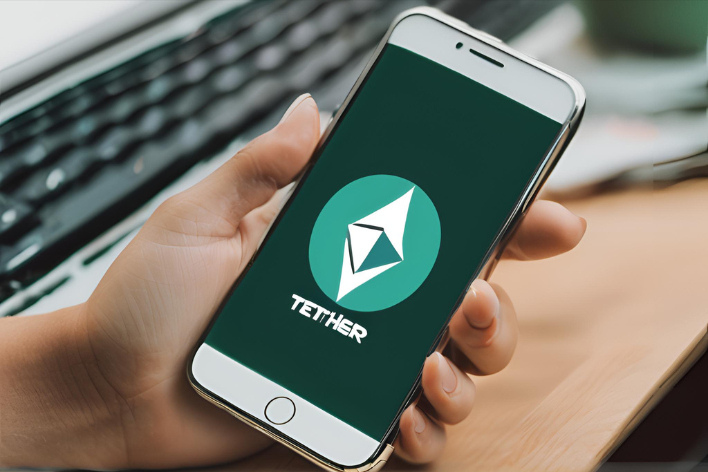The Role of Tether (USDT) in the Cryptocurrency Ecosystem
INTRODUCTION:
Tether (USDT) has become a crucial component of the cryptocurrency ecosystem, providing a stable and reliable asset amidst the market’s notorious volatility. As a stablecoin pegged to the US dollar, USDT provides traders and investors with a secure haven, facilitating seamless transactions and acting as a bridge between traditional finance and digital currencies. In this post, we’ll delve into how Tether operates, its benefits, and its crucial role in the ever-evolving world of cryptocurrency.
What is Tether (USDT)?
Tether (USDT) stands out as a leading stablecoin, providing a digital asset with the reliability of a traditional currency. Its primary function is to provide a digital alternative to traditional fiat currencies, most commonly pegged to the US dollar. Here’s a detailed breakdown of Tether (USDT):
Key Characteristics:
1. Stable Value:
Pegging: USDT maintains a 1:1 peg with the US dollar, meaning one USDT token is equivalent to one US dollar. This is achieved by holding reserves equal to the number of USDT tokens in circulation.
2. Issuance and Backing:
Tether Limited: The company behind USDT, Tether Limited, issues these tokens. They claim to hold fiat reserves equivalent to the total supply of USDT, ensuring its value remains stable.
Reserves: These reserves are supposed to include traditional currency and cash equivalents, and, from time to time, may include other assets and receivables from loans made by Tether to third parties.
3. Blockchain Compatibility:
Multiple Platforms: Initially launched on the Bitcoin blockchain via the Omni Layer, USDT has since expanded to multiple blockchains, including Ethereum (ERC-20), Tron (TRC-20), and others, increasing its accessibility and utility across various platforms.
How Does Tether (USDT) Work?
Functions and Uses:
1. Trading and Hedging:
Market Stability: USDT provides a stable store of value that traders can use to hedge against market volatility.
Liquidity: It offers high liquidity on numerous exchanges, making it easy to convert to and from other cryptocurrencies quickly and efficiently.
2. Transactions:
Fast Transfers: Enables faster and cheaper cross-border transactions compared to traditional banking methods.
Remittances: Used for sending remittances due to its stable value and low transaction fees.
3. Decentralized Finance (DeFi):
Lending and Borrowing: Integrated into DeFi platforms for lending and borrowing, yield farming, and other financial services, providing a stable asset for various protocols.
Advantages of Using Tether (USDT)
Tether (USDT) offers several benefits, making it a popular choice among cryptocurrency users. Here are some key advantages:
1. Stability:
Less Volatile: Unlike other cryptocurrencies, USDT's value remains relatively stable, protecting users from the extreme price swings typical in the crypto market.
2. Accessibility:
Wide Acceptance: It is widely accepted on nearly all major cryptocurrency exchanges and wallets.
3. Convenience:
Ease of Use: Facilitates easier trading, as users can quickly convert their volatile crypto holdings into a stable asset without exiting the digital space.
4. Transparency and Auditability:
Regular Audits: Tether Limited provides regular attestations of its reserves, aiming to maintain transparency and build trust among users. These audits verify that each USDT token is backed by equivalent fiat reserves.
Common Uses of Tether (USDT)
1. Stable Trading Pair
Tether frequently serves as a trading pair on cryptocurrency exchanges. Traders use USDT to buy and sell other cryptocurrencies without needing to convert back to fiat currencies, helping to maintain liquidity and manage market positions.
2. Hedging Against Volatility
Investors use USDT as a safe haven during periods of high volatility in the cryptocurrency market. By converting their holdings to USDT, they can avoid potential losses from market fluctuations while waiting for better trading opportunities.
3. Cross-Border Transactions
Tether facilitates cross-border transactions by providing a stable and easily transferable asset. It allows users to send and receive value across borders without dealing with the complexities and fees of traditional banking systems.
How to Acquire Tether (USDT)
Buying USDT on Cryptocurrency Exchanges:
Buying Tether (USDT) on a cryptocurrency exchange is a straightforward process. Here's an overview to help you through it:
a. Choose a Reputable Exchange: Select a cryptocurrency exchange that supports USDT trading. Some popular exchanges include:
Binance
Coinbase
Kraken
Bitfinex
Gemini
b. Create an Account: Sign up for an account on the chosen exchange by providing your email address, creating a password, and completing identity verification (KYC process).
c. Deposit Funds: Deposit fiat currency or cryptocurrency into your exchange account. Most exchanges accept deposits via bank transfer, credit/debit card, or cryptocurrency transfer.
d. Buy USDT: Navigate to the trading section of the exchange and select the USDT trading pair (e.g., BTC/USDT, USD/USDT). With your deposited funds, you can place an order to buy USDT.
e. Withdraw to Wallet (Optional): For added security, consider withdrawing your USDT to a personal wallet rather than keeping it on the exchange.
Storing Tether (USDT)
Properly storing Tether (USDT) is crucial for security and managing your crypto assets effectively. Here’s a comprehensive guide on how to store USDT safely and efficiently:
1. Understanding Different Types of USDT
USDT is available on various blockchain networks, and it’s essential to choose the right one based on your storage method:
ERC-20: Runs on the Ethereum blockchain.
TRC-20: Runs on the TRON blockchain.
BEP-20: Runs on the Binance Smart Chain (BSC).
Omni: Runs on the Bitcoin blockchain.
Make sure the wallet you choose supports the specific network of USDT you hold.
2. Types of Wallets for Storing USDT
a. Hardware Wallets
Description: Physical devices that store your private keys offline, providing the highest level of security.
Popular Hardware Wallets:
Ledger Nano X: Supports ERC-20, TRC-20, BEP-20, and Omni USDT.
Trezor Model T: Supports ERC-20 USDT and other cryptocurrencies.
b. Software Wallets
Description: Applications or programs for desktops and mobile devices that store private keys online.
Popular Software Wallets:
MetaMask: Supports ERC-20 USDT.
Trust Wallet: Supports ERC-20, TRC-20, and BEP-20 USDT.
Exodus: Supports ERC-20 USDT.
c. Exchange Wallets
Description: Wallets provided by cryptocurrency exchanges where you can store your USDT.
Popular Exchanges:
Binance
Coinbase
Kraken
3. Best Practices for Storing USDT
a. Security Measures
Use Strong Passwords: Ensure your wallet and exchange accounts have strong, unique passwords.
Level Up Your Security: Enable Two-Factor Authentication (2FA). To upgrade your security.
Backup Your Wallet: Keep a secure backup of your wallet’s seed phrase or private keys.
Keep Software Updated: Regularly update your wallet software and apps.
b. Safe Transactions
Double-Check Addresses: Always verify the wallet address before making transactions.
Use Trusted Networks: Perform transactions on secure and private networks.
c. Regular Monitoring
Check Balances: Regularly monitor your USDT balance and transaction history.
Watch for Phishing Scams: Be wary of phishing emails or messages asking for your private information.
d. Diversification
Consider Spreading Funds: Store USDT across different wallets for added security and flexibility.
Potential Risks and Considerations:
1. Security Risks
a. Hacking and Theft
Risk: Hackers may target exchanges or wallets.
Consideration: Use reputable exchanges and secure wallets. Enable two-factor authentication (2FA) and keep your private keys offline.
b. Phishing Scams
Risk: Fraudulent schemes may trick you into revealing your information.
Consideration: Be cautious of emails or messages asking for your private keys or personal details. Always verify URLs and use official sites.
2. Wallet Issues
a. Software Vulnerabilities
Risk: Bugs or vulnerabilities in wallet software.
Consideration: Regularly update your wallet software and use trusted, well-reviewed apps.
b. Lost or Stolen Devices
Risk: Losing access to your wallet.
Consideration: Back up your wallet’s seed phrase or private keys in a secure location. For hardware wallets, keep the device and backup safe from theft.
3. Backup and Recovery
a. Loss of Recovery Phrase
Risk: Losing your recovery phrase means losing access to your wallet.
Consideration: Store your recovery phrase in a safe and secure place. Consider using a secure offline backup method.
The Future of Tether (USDT)
As of March 2024, USDT stands as the third-largest cryptocurrency by market capitalization, behind Bitcoin (BTC) and Ethereum (ETH), and holds the title of the largest stablecoin with a market cap of nearly $99 billion. Additionally, USDT has accounted for the majority of cryptocurrency exchange volume in 2023 and early 2024, underscoring its significance in the digital asset ecosystem. Given this strong position, what does the future hold for USDT? Let’s explore some potential trends and developments.
1. Increased Adoption and Use Cases:
Trend: USDT’s role in DeFi is set to grow. As DeFi platforms continue to expand, USDT will likely be a top choice for lending, borrowing, and liquidity provision due to its stability and liquidity.
Future Outlook: Expect to see USDT increasingly used in DeFi projects as more users and developers turn to stablecoins for their financial activities.
2. Technological and Network Developments:
Trend: Tether will likely continue improving its existing blockchain platforms (ERC-20, TRC-20, BEP-20) for better performance and lower costs.
Future Outlook: Expect upgrades that enhance transaction speeds, reduce fees, and increase overall network efficiency.
3. USDT’s Market Position and Trading Volume:
Current Status: As of March 2024, USDT is the third-largest cryptocurrency by market cap and the leading stablecoin.
Future Outlook: Its significant market position will drive further developments and innovations to maintain this status.
Final Thoughts:
Tether (USDT) is more than just a stablecoin; it’s a key component of the modern cryptocurrency landscape. By understanding its role, learning how to acquire it, and adopting best practices for storage and security, you can make the most of what USDT has to offer. Whether you’re looking to stabilize your crypto portfolio, explore DeFi opportunities, or simply move funds efficiently, USDT is a valuable tool in your crypto toolkit.
Thank you for reading, and we hope this guide helps you navigate the world of Tether with confidence!





